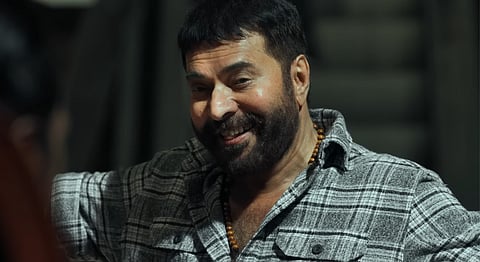Turbo review: Mammootty’s star vehicle is let down by cliché-ridden plot
Turbo (Malayalam)(2.5 / 5)
In the very first fight scene in director Vysakh’s Turbo, pitched as a high-octane action entertainer, Mammootty as Turbo Jose swivels into the premises of a palli perunnal (church festival) in his sleek black jeep, and on cue, a massive board that says ‘MEGA SHOW’ lights up in the background. We immediately know what we are in for — a template mass potboiler that rides on Mammootty’s star power — and to Turbo’s credit, it doesn’t pretend to be anything more. After the year that Mammootty had, where he was credited for ‘redefining’ the idea of a superstar with his series of experimental class acts, he too settles back into the comfortable star vehicle with ease. It’s nothing he hasn’t done before.
Aruvipurathu Jose, or Turbo Jose, is that same indestructible hero we have seen shades of in several Mammootty films, ranging from Vysakh’s own Pokkiri Raja to the cult classic Valliettan. Jose has a tragic past, can take punches like nobody’s business, and is a big brother of sorts to the young’uns that flock around him. He is also a complete mamma’s boy, as one of the characters in the film calls him.
His mother, played charmingly by Bindu Panicker, keeps Jose in his lane and has no qualms about dropping a swear word or two when she deems it fit. Though Turbo by and large remains an action flick, Mammootty and Bindu together deliver some of the funniest quips in the film. Other instances of comic relief come from the gangster Auto Billa, played by Tamil actor Sunil, who dresses and acts like Don Vito Corleone from The Godfather in a fun spoof attempt. Anjana Jayaprakash as Indulekha and Shabareesh Varma as Jerry drive the story forward, delivering grounded performances.
It’s halfway through the film that the pace really picks up, though Midhun Manuel Thomas’ script remains predictable at every turn. Midhun said in an interview that the massive bank scam, which is at the centre of the film, is inspired from real life incidents, but that scam is as far as the film’s novelty goes. But Turbo markedly stays away from some of the misogynistic tropes that Vyshakh’s films (and many other star vehicles) have previously succumbed to — a low bar, but a step in the right direction nevertheless. The presence of a strong woman character at the heart of the film also comes as a welcome relief, in a year of Malayalam cinema where, so far, women seemed to have been consistently left out of narratives.
One of Turbo’s biggest selling points, apart from Mammootty, is the appearance of Raj B Shetty as the diabolical antagonist Vetrivel Shanmugha Sundaram. The film creates a lot of build-up for the character, setting him up as a vicious kingmaker who has spread a “blanket of fear” over the city. He is said to be a sadist who “kills for sport.” He repeatedly claims to hate clichés, though he is as clichéd as villains come, dropping his Shaolin swords to face his formidable opponent with his bare hands instead of killing him when the opportunity presents itself.
Watch the film's trailer here:
It speaks to Raj B Shetty’s skill level that he brings just the adequate amount of menace and swagger to the character, his sinister smiles enough to send shivers down one’s spine. But by the time he is introduced, we have already seen what Turbo Jose is capable of and the antagonist simply doesn’t rise up to the simpleton from Idukki.
Credit to the stunt and VFX teams and to cinematographer Vishnu Sharma, some of the stunt and chase sequences in Turbo are exhilarating, with Mammootty once again in his element as an action hero. Despite the occasional letdowns, the music and background score by Christo Xavier also live up to the film’s energy for the most part, amping up the thrills that the stunts seek to deliver.
Turbo is a small step up from the run-of-the-mill, misogynistic star vehicles that our superstars have formerly been guilty of, solely because it seems relatively unproblematic, but it would still rank rather low in Mammootty Kampany’s (so far) illustrious filmography. The makers, by the end of the film, hint at the possibility of a sequel, but it would probably do them good to expend that energy elsewhere.
Disclaimer: This review was not paid for or commissioned by anyone associated with the film. Neither TNM nor any of its reviewers have any sort of business relationship with the film’s producers or any other members of its cast and crew.

